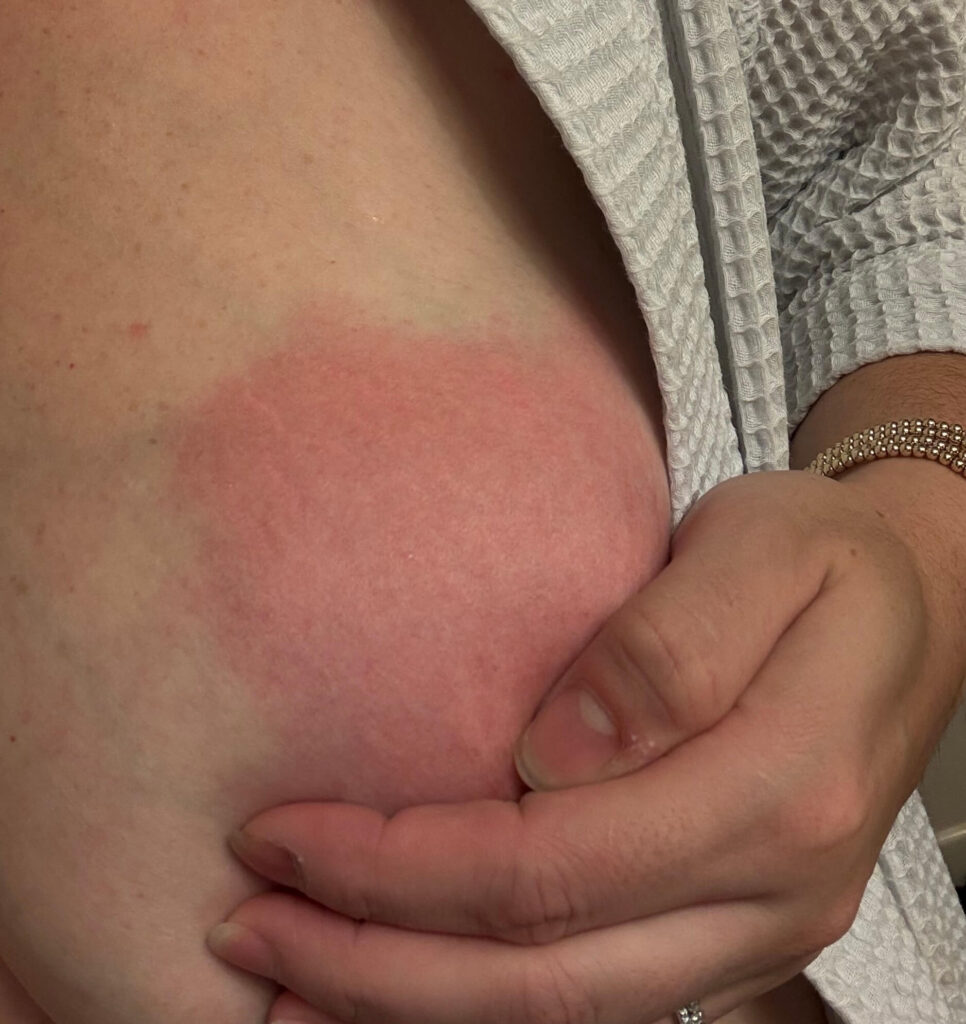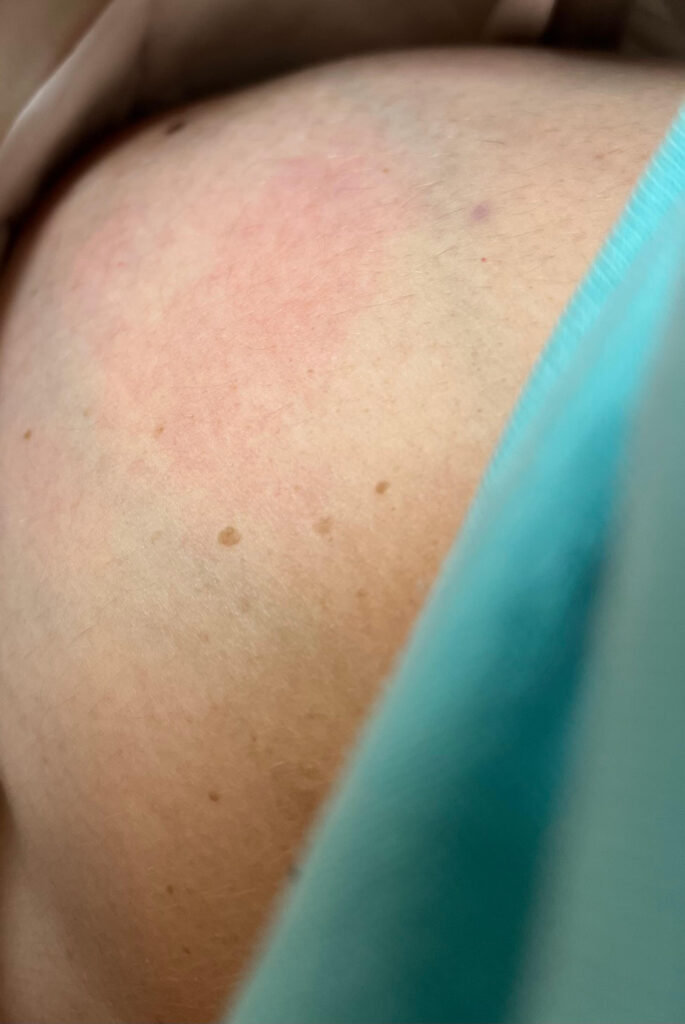Your Complete Guide to Managing Mastitis
January 15, 2025
Did you know 1 in 3 breastfeeding parents will develop mastitis at some point in their breastfeeding journey? Yikes, that is not a fun statistic. When it comes to managing mastitis, there is a lot of conflicting information floating around out there. However, the Academy of Breastfeeding Medicine (ABM) recently updated their protocol on managing mastitis and our understanding surrounding how it happens.
After reading this you’ll have a better understanding of why mastitis happens, how to effectively manage mastitis from home, when to seek additional help (and the evidence-based ways to treat it), and things you can do to avoid future cases of mastitis.
What is Mastitis?
The Academy of Breastfeeding Medicine (ABM) defines mastitis as “inflammation of the mammary gland that most often presents in a segmental distribution of ducts, alveoli, and surrounding connective tissue”. They go on to state this ductal narrowing is caused by edema associated with hyperlactation as well as mammary dysbiosis.
Let’s make all that easier to digest…
We used to think a clogged duct was quite literally a clog in the milk duct caused by stagnant milk just sitting there causing a back-up of breast milk. The ABM states “ducts in the breast are innumerable and interlacing and it is not physiologically or anatomically possible for a single duct to become obstructed with a macroscopic milk ‘‘plug.’’
We now know that it’s actually ductal narrowing caused by inflammation. Picture your milk duct like a straw. Now you’re going to pinch that straw in the middle. It’s a lot harder to get liquid from the straw now, right? That’s what happens when inflammation (we’ll discuss why in a moment) presses in on your milk duct. It narrows that duct making it harder for breast milk to move through freely.
That’s when we feel that tender, swollen lump in the breast– which is the breast milk backing up behind that ductal narrowing and causing further inflammation.

What Causes Mastitis?
We no longer consider mastitis a single condition, but rather a spectrum of conditions (ductal narrowing, inflammatory mastitis, bacterial mastitis, etc).
The ABM states multiple factors contribute to the development of mastitis and “include host factors such as hyperlactation, microbial factors such as diversity of the milk microbiome, and medical factors such as antibiotic and probiotic use”.
Hyperlactation is producing more milk than needed, also known as oversupply.
And mammary dysbiosis is the disruption of the balance of bacteria in the breast which can be affected by maternal genetics or medical conditions, exposure to antibiotics, use of probiotics, regular use of breast pumps, and cesarean births.
These are risk factors that can make a person more likely to develop mastitis.
What’s the Difference Between a Clogged Duct and Mastitis?
Now that research shows mastitis is a spectrum of conditions, we can see that inflammatory mastitis begins with ductal narrowing (aka a clogged duct).
If the clogged duct is not treated quickly and efficiently and the surrounding inflammation progresses, it will progress to inflammatory mastitis and continue to worsen through the mastitis spectrum.
We can see a difference in the symptoms noted with a clogged duct or mastitis. Ductal narrowing should only produce local symptoms such as a swollen, tender lump (area of congestion) and mild redness. Mastitis produces systemic symptoms such as body aches, chills, and fever.

Managing Mastitis at Home
This is not medical advice and does not replace the fact that you should be in communication with your provider if you are experiencing mastitis symptoms. That said, let’s discuss the recent updates to the ABM protocol that you can do at home to help resolve symptoms.
Feed baby on demand (or pump on regular schedule): Feed your baby on demand (when they show hunger cues) and don’t try to overly empty the breasts. We don’t want to be pumping more than usual as this tells our body to make more milk and can actually worsen the inflammation.
Wear an appropriately fitting, supportive bra: A supportive bra can help with inflammation but shouldn’t be too tight or restrictive as that can cause clogs.
Apply ice: You can apply ice to the affected area for 15 minutes at a time hourly to reduce inflammation and help with discomfort.
Take ibuprofen and/or acetaminophen: Ibuprofen is used to reduce inflammation and can also be used as an analgesic (pain reliever). And acetaminophen (Tylenol) can be used for pain relief if needed.
Light lymphatic massage: This is a technique helpful to move excess fluid into the lymphatic system to help with drainage. We want to use really gentle touch, as if you were stroking your baby’s face. You will use your palm and fingers to stroke from the center of the breast in an upward motion. You can find a tutorial of how to perform the technique here.
Breast gymnastics: This is an exercise that is great for engorgement or mastitis. You will gently hold your breast and circle it around in different directions (up, down, left right). Continue for a minute or so and switch sides as necessary. This helps moves the fluid build up in the breast and decrease swelling.
Consider probiotics: Though the data regarding probiotic use is mixed, it doesn’t hurt to attempt to balance the breast microbiome. Especially if dealing with recurrent cases of clogged ducts or mastitis. The ABM states “a systematic review suggested that probiotics may be effective for both treatment and prevention of mastitis, but a strong recommendation could not be made due to limitations of the studied trials.”
This supplement by Lactation Hub is a great option!
Choline supplementation: Choline is an essential nutrient that supports brain and nervous system development in baby and in mothers it reduces inflammation and can help with milk flow. Sunflower lecithin is commonly recommended to breastfeeding mothers when experiencing clogged ducts or mastitis. This is because sunflower lecithin contains choline.
Sunflower lecithin can also cause GI upset in some mothers and disrupt the lining of the gut. For this reason, taking a direct choline supplement seems to be more effective. Women who are breastfeeding are recommended to consume 550 mg of choline daily throughout the first year postpartum (but often aren’t consuming enough). For more information on choline, check out this article.
What Not To Do
We’ve learned with the recent updates to the ABM mastitis protocol that what we used to believe treats mastitis can actually worsen inflammation and symptoms. So if you see these recommendations floating around out there, just know they are outdated advice.
Deep massage of the breast: Aggressive, deep massage increases inflammation and worsens symptoms. Imagine deeply massaging a sprained ankle, it wouldn’t be pleasant and wouldn’t speed up healing time. Remember, there isn’t actually a “clog” in the milk duct so there’s no reason to be attempting to push anything out.
Saline soaks: A common past recommendation was to use a haakaa and fill it with warm water with epsom salts to help draw the clog out. Research shows this can worsen edema and should be avoided.
Pumping or removing milk in excess: The only time I recommend pumping when experiencing a clogged duct or mastitis is if your baby is nursing at the breast and not emptying you well. Otherwise, feed on demand and pump as normal.
Excessive use of heat: Heat vasodilates and can worsen inflammation. However, some mothers may find warm showers provide comfort or the use of a heating pad during feedings/pumping sessions to help with milk flow. Just don’t overdo it.
Managing Decreased Milk Supply
It is possible that your milk supply may experience a decrease after dealing with ductal narrowing or mastitis.
That doesn’t mean it will be decreased forever though. Depending on how many weeks/months postpartum you are will determine how difficult it will be to get your milk supply back to where it was. The earlier postpartum you are, the easier it is to get your supply back up.
You’ll want to ensure you’re staying hydrated and consuming enough calories, resting as much as possible, and removing milk efficiently and as frequently as you were before experiencing a clogged duct or mastitis.
When to Call Your Provider
Some cases of mastitis can be treated at home with ice, anti-inflammatories, and rest. However, if you develop a fever or any other systemic symptoms such as body aches or chills or your symptoms don’t resolve within 24 hours, you should reach out to your health care provider.
Antibiotic Management of Mastitis
The ABM protocol has specific recommendations for first line and second line antibiotic treatment for mastitis.
FIRST LINE
Dicloxacillin or flucloxacillin 500 mg QID for 10–14 days
Cephalexin 500 mg QID for 10–14 days
SECOND LINE
Clindamycin 300 mg four times daily for 10–14 days
Trimethoprim-sulfamethoxazole DS BID for 10–14 days (not recommended for mothers of children with G6PD deficiency, and use caution in mothers with premature infants or infants with hyperbilirubinemia – especially under 30 days old)
Some doctors aren’t up to date on the recent ABM recommendations. If you experience this, you can present them with the Academy of Breastfeeding Medicine protocol #36. You can either refer them to it or print out the protocol and bring it with you to your appointment.
Is it safe for my baby to drink my breast milk when I have mastitis?
Yes! It’s completely safe for your baby to continue breastfeeding if you have inflammatory or bacterial mastitis. If you ever have any concerns, you may refer to the InfantRisk Center (or your provider of course).
How to Prevent Future Cases of Clogged Ducts or Mastitis
There are a few things we can do to help prevent clogged ducts or mastitis from reoccurring.
Improve your breast microbiome: You can do this by eating a diverse diet and avoiding washing your breasts with any harsh soaps. You may also choose to take a probiotic supplement (again, I love the one by Lactation Hub because it includes choline as well!).
Avoid tight bras or clothing: Any restrictive clothing on your breasts can cause ductal narrowing leading to further inflammation. Underwire bras should also be avoided.
Using your breast pump efficiently: If you’re pumping, ensure you’re using your breast pump settings to the fullest to efficiently remove breast milk. Also be sure you’re using the proper flange size.
If nursing, ensure baby has a good latch: If your baby is nursing and you continue to get clogged ducts or mastitis, an assessment should be done with a lactation consultant to ensure baby is latching as they should.
Address oversupply: If you have an oversupply, this could be a major cause for frequent cases of clogged ducts or mastitis. Working closely with a lactation expert would be best to help you down-regulate or figure out how to appropriately manage the oversupply without continuing to get “clogs”.
Ready for more support?
Join The ESSENTIALS Program! We provide you with comprehensive prenatal education modules covering everything you need to know before (and after) baby gets here. As well as unlimited 1:1 messaging with our lactation experts, weekly live zoom drop-in Q&A sessions, private moderated community chat, and so much more!
We can help you manage common challenges like oversupply, clogged ducts/mastitis, engorgement, poor latch, and so much more. Let us be your village!
Leave a Reply Cancel reply
Privacy Policy
Site Credit
Terms and Conditions
For the moms who want breastfeeding to feel enjoyable, not overwhelming. With expert guidance and heartfelt support, I'll help you nourish your baby with confidence and ease - goodbye chaos, hello clarity.
@Juneandlily
© HEY SLEEPY BABY x ELDEST DAUGHTeR STUDIO